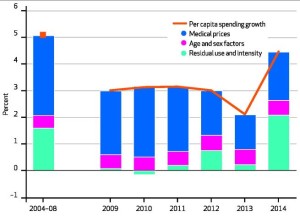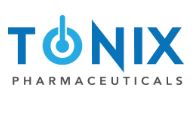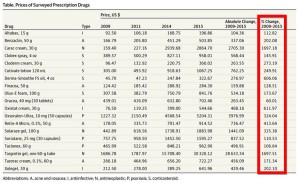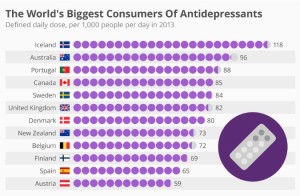- Tonix Pharma, U.S. Defense Department partner on PTSD drug (reuters.com)
Tonix Pharmaceuticals Holding Corp said it was teaming up with the U.S. Department of Defense to further develop its experimental PTSD drug, which if approved, could be the first treatment for the psychiatric disorder in more than 15 years…The Cooperative Research and Development Agreement with the Department of Defense will allow Tonix to gain access to and study military personnel who are on active duty…"Since we are specifically seeking a label for military-related PTSD for our drug, it's important to study these patients as the active duty personnel are closer to traumatic events, as opposed to veterans,"… Tonix's TNX-102 is currently being tested in mid-stage studies and has a long path to approval…Some analysts have called the drug a "dark horse" opportunity, which could be transformative for the company…The only two drugs currently approved for PTSD - Zoloft and Paxil - come with substantial side effects. Tonix's drug is intended to improve sleep quality in these patients, which is considered to be a crucial characteristic of the disease.
- National Health Spending In 2014: Faster Growth Driven By Coverage Expansion And Prescription Drug Spending (content.healthaffairs.org)

Factors Accounting For Growth In Per Capita National Health Expenditures, Selected Calendar Years 2004–14
US health care spending increased 5.3 percent to $3.0 trillion in 2014. On a per capita basis, health spending was $9,523 in 2014, an increase of 4.5 percent from 2013. The share of gross domestic product devoted to health care spending was 17.5 percent, up from 17.3 percent in 2013. The faster growth in 2014 that followed five consecutive years of historically low growth was primarily due to the major coverage expansions under the Affordable Care Act, particularly for Medicaid and private health insurance, which contributed to an increase in the insured share of the population…growth in total retail prescription drug expenditures accelerated sharply, increasing 12.2 percent to $297.7 billion…The strong growth in prescription drug expenditures in 2014 was caused by increased spending on new medicines, a smaller impact from patent expirations than in previous years, and price increases for brand-name drugs. The single largest driver of growth in specialty drug spending in 2014 was the impact of new treatments for hepatitis C, which contributed $11.3 billion in new spending.
The Affordable Care Act | Factors Accounting For Growth | Revisions To The National Health Expenditure Accounts | Sponsors Of Health Care | Private Health Insurance | Medicaid | Medicare | Out-Of-Pocket Spending | Retail Prescription Drugs | Hospital Care | Physician And Clinical Services
- Prices are skyrocketing for skin creams and pills (statnews.com)Changes in Retail Prices of Prescription Dermatologic Drugs From 2009 to 2015 (archderm.jamanetwork.com)
You may need a thick skin to withstand the rising cost of some dermatology medicines…A new study finds that prices of some widely prescribed creams and pills for skin conditions rose rapidly between 2009 and 2015. Of the 19 brand-name medicines analyzed, the retail prices of seven more than quadrupled…Prices for some generic drugs also rose considerably. Between 2011 and 2014, there was a mean increase of 279 percent, although prices for a few drugs remained largely unchanged…“The prices have skyrocketed with no justification,”…“This is a manifestation of anarchy pricing, which is what you get when you don’t have a competitive free market or competent government actions to protect patients,”...
- The World’s Biggest Consumers Of Antidepressants (forbes.com)
Iceland is the biggest consumer of antidepressants worldwide, according to recent OECD (Organisation for Economic Cooperation and Development) report entitled “Health at a Glance 2015.” Some 118 out of every 1,000 Icelanders now consume these drugs on a daily basis, though the trend certainly isn’t new...Some experts attribute the country’s use of these drugs to a weakening of social taboos, along with a greater tendency to seek treatment. Some also believe there is a link between antidepressant consumption and the failure of all three of Iceland’s main banks during the financial crisis. Australia is in second position with 96 out of every 1,000 people taking antidepressants daily, while Portugal rounds off the top three with 88 per 1,000.
- How scientists rank drugs from most to least dangerous — and why the rankings are flawed (vox.com)
There's a very common drug-policy talking point that's meant to convey the absurdity of the war on drugs: Alcohol is more dangerous than marijuana, even though alcohol is legal and marijuana is not…Perhaps the biggest supporting evidence for this point is a 2010 study published in The Lancet that ranked alcohol as the most dangerous drug in the United Kingdom… Although drug policy experts generally don't dispute the assertion that alcohol is more dangerous than pot, the study, led by…David Nutt, is quite controversial. Experts see the rankings as deeply flawed, largely because they present the harms that come from drugs in a rather crude, one-dimensional manner. Even Nutt has acknowledged that the study is imperfect…There probably isn't a perfect way to evaluate and present all drug harms. Researchers will always need to balance making information simple and accessible for policymakers and the public with the inherent complexity of drugs and their effects. This makes the task of building scientific drug policies very challenging…The analysis may be flawed, but its simplicity and accessibility have won over many policy circles.
- Prisons can lock up savings by treating inmates with hepatitis C (statnews.com)
Here’s a chance to lock up some savings…The high cost of hepatitis C drugs may be straining budgets nationwide, but the country can save money if prison inmates are screened and treated for the disease… researchers determined that treatment could lower infection among both prisoners and society…If more inmates are treated, the disease would be less likely to spread within prisons, where an estimated 17 percent of the population is already infected. Beyond that, hepatitis C would be less likely to spread in the wider population once inmates are released. About 1 percent of the general US population is believed to have hepatitis C…screening and treatment would require an added 12.4 percent increase in the health care budgets of state and federal prisons during the first year such an effort is undertaken. But that would eventually decline to an annual budget increase of less than 0.7 percent after 15 years…prices have prompted many public and private payers to restrict access to treatment…a...class action lawsuit was filed earlier this year by two inmates in Massachusetts state prisons for failing to provide hepatitis C treatment to most infected prisoners…
- One in Four Americans Has Been Addicted to Painkillers or Is Close to an Addict (bloomberg.com)
New data show the staggering reach of the prescription drug epidemic...Doctors wrote 259 million opioid prescriptions for Americans in 2012, enough to medicate every adult in the country. Drug overdoses are eclipsing car crashes as a leading cause of accidental death for American adults…A poll out today from the Kaiser Family Foundation adds a troubling new number to the accounting: 27 percent of Americans report that they either have been addicted to prescription painkillers or have a family member or close friend who has…That's roughly 66 million U.S. adults for whom the opioid crisis has become intensely personal…Prescription drug addiction and a related heroin epidemic have proven a stubborn public health crisis since painkiller abuse began rising more than a decade ago…Kaiser's poll found strong majorities in support of policy solutions, including drug treatment, tighter scrutiny of prescribers, and "good samaritan" laws that protect drug users from being charged if they call for help when addicts overdose.
- ADHD drugs may be a prescription for bullying (reuters.com)
Kids and teens who take prescription medicines to treat attention-deficit hyperactivity disorder may be twice as likely to be bullied as their peers who don’t have this mental health problem… Adolescents who sold their prescribed drugs to other kids – who might want the stimulants for study or diet aids – had more than four times greater odds of being bullied than their peers without ADHD…Our findings show that there is some connection between a prescription for stimulant medications and bullying, even after accounting for the fact that adolescents with ADHD may have difficulties with peers or may have other problem behaviors associated with victimization…
- Apple Watch used to study epileptic seizures (baltimoresun.com)Johns Hopkins EpiWatch: App and Research Study (hopkinsmedicine.org)
For the 2.5 million people living with epilepsy… medications can help control their seizures — most of the time. But some suffer unpleasant side effects from the drugs. And a few remain at risk of death…Researchers at the Johns Hopkins University hope to help those with the neurological condition by collecting information about their seizures through their…Apple Watches…"Physicians often ask patients to record their seizures, but that can be hard, especially when a patient loses consciousness," said Dr. Gregory Krauss…who is working on the program, named EpiWatch…collects data that help researchers better understand epilepsy, while helping patients keep a more complete history of their seizures," he said…The data could not only help doctors adjust an individual's treatment to make it more effective and less burdensome, but could also help...counter sudden unexpected death, a danger some face from seizures.
- Expensive new Hep C drugs may be cost-effective even for early disease (reuters.com)
Treating hepatitis C with expensive new medicines at the earliest signs of liver damage improves patients' health and is also cost-effective, a new computer simulation suggests…"Going into this, I expected to find it did make sense to wait until there was a limited amount of liver disease, but what we found to our surprise is that it makes sense to start treatment at the earliest change in the liver,"…researchers created a simulated model to study the cost-effectiveness of a medicine…The imaginary subjects…of varying ages and with various stages of liver damage… While treating all stages of liver disease was cost-effective, the up-front cost is substantial. Treating half of those with hepatitis C would cost about $53 billion. That cost can be brought down if the price of the drug also decreases, the researchers write…"I think a key policy point here is that cost-effectiveness is important and this study shows that, but a next and important step is...to address the cost of the drug,"






